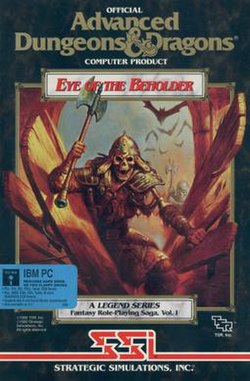Critical reception
Eye of the Beholder was reviewed in 1991 in Dragon #171 by Hartley, Patricia, and Kirk Lesser in "The Role of Computers" column, who gave it 5 out of 5 stars. [15] It was #1 on the Software Publishers Association's list of top MS-DOS games for April 1991, the last SSI D&D game to reach the rank. [21] Dennis Owens of Computer Gaming World called it "a stunning, brilliantly graphic and agonizingly tricky" 3-D CRPG. The magazine stated that the game's VGA graphics and sound card audio finally gave IBM PC owners a Dungeon Master-like game. [22] Scorpia, another reviewer for the magazine, was less positive. Although also praising the graphics and audio, stating that they "really give you the feeling of being in an actual dungeon", she criticized the awkward spell user interface and the "outrageous" abrupt ending. Other areas that needed work included the combat, plot, and NPC interaction; nonetheless, she was hopeful that with such improvements "the Legend series will become one of the leaders in the CRPG field". [23] In 1993, Scorpia called the game "an impressive first effort that bodes well for the future". [24]
Jim Trunzo reviewed Eye of the Beholder in White Wolf #27 (June/July, 1991), rating it a 5 out of 5 and stated that "While the unforgiving nature of Eye of the Beholder makes the basic dungeon crawl a challenge, the graphics and sound employed in the game might well make it a classic!" [25]
The One gave the Amiga version of Eye of the Beholder an overall score of 92%, heavily comparing it to Dungeon Master , stating that "comparisons to the [aging] classic – Dungeon Master – are inevitable. When two games look this similar, even their programmers would have trouble telling them apart". The One praises Eye of the Beholder's gameplay, stating that "in contrast to previous AD&D titles, there's more emphasis on puzzle-solving than combat – a refreshing change ... Combat is also handled extremely well, the spells and 'ranged weapons' rules are all faithful to the original game ... The gameplay works wonderfully, conjuring up both the spirit and the atmosphere that you get from [tabletop AD&D]". Despite this, The One expresses that Eye of the Beholder is on par with Dungeon Master and Chaos Strikes Back , but states that Eye of the Beholder is still "an essential purchase for followers of the AD&D series". [19]
Hailing the game as "a dream come true" for Dungeons & Dragons fans, Electronic Gaming Monthly gave the Super NES version a 6.2 out of 10, praising its 3-D graphics and variety of characters. [17] They gave the Sega CD version a 7.2 out of 10, this time praising the ability to create custom characters but criticizing the audio. They also remarked that the game has a difficult learning curve. [16] While reviewing the Sega CD version, Computer and Video Games said it is "not quite up there with Snatcher , but without doubt a highly ace role-player". [14]
According to GameSpy in 2004, despite the issues in the first Eye of the Beholder, "most players found the game well worth the effort". [26] IGN ranked Eye of the Beholder No. 8 on their list of "The Top 11 Dungeons & Dragons Games of All Time" in 2014. [27] Ian Williams of Paste rated the game #8 on his list of "The 10 GreatestDungeons and Dragons Videogames" in 2015. [28] In 1991, PC Format placed Eye of the Beholder on its list of the 50 best computer games of all time. The editors called it a "classic romp through dungeons dealing with monsters, puzzles, traps and things mythical". [29]

